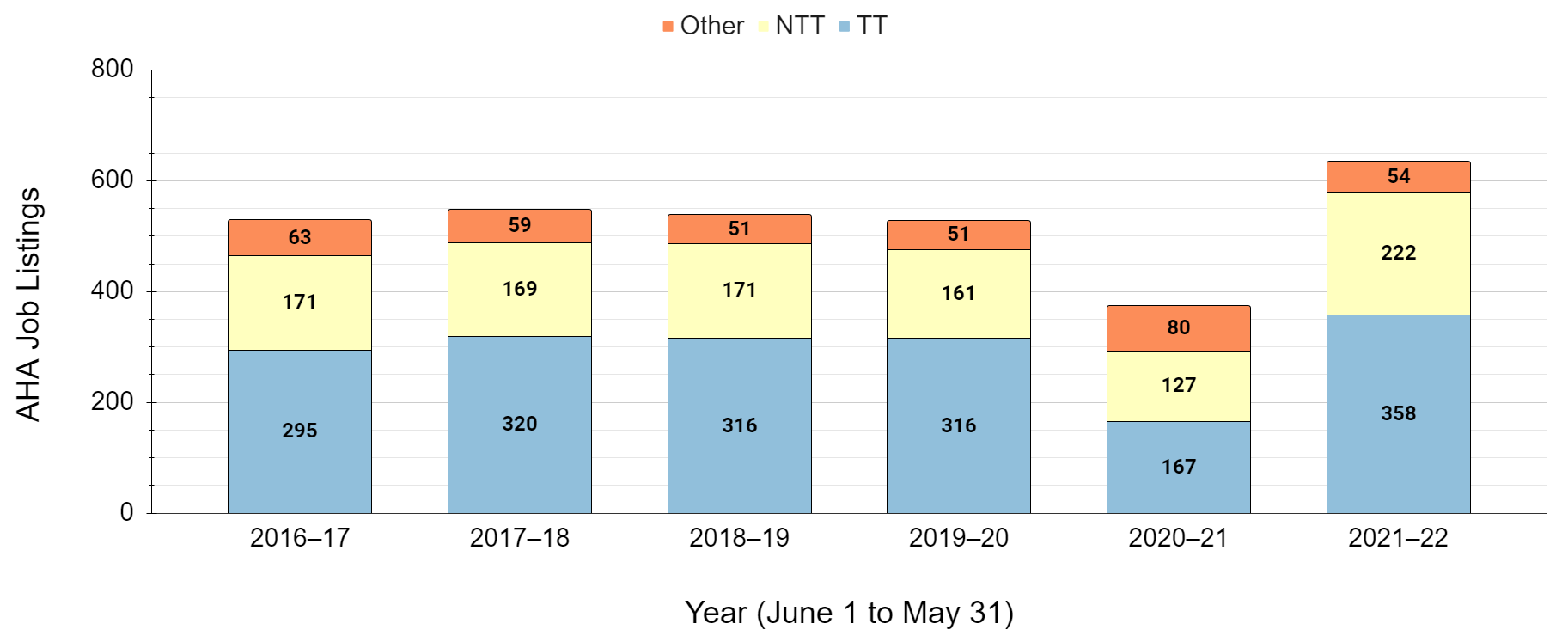The effect of COVID-19 on academic hiring was swift and brutal. The 2020–21 academic year had the fewest professorial job listings in history since the AHA first started keeping records in 1975. Pandemic-related austerity measures, hiring freezes, and the like were implemented by almost every US university, and the resulting downturn was as expected as it was unwelcome.
The availability of jobs from 2016–17 to 2019–20 had been remarkably stable, as had the relative ratios of tenure-track (TT), non-tenure-track (NTT), and nonteaching jobs (Fig. 1). This period saw an average of 536 jobs listed per year (standard deviation [SD] 9), of which 312 (SD 11) were TT, 168 (SD 5) were NTT, and 56 (SD 6) were nonteaching positions. Although these numbers were far from encouraging, the consistency was a relative improvement from years of continuous decline following the 2008 market crash.

Fig. 1: Job listings on the AHA Career Center by type and year from 2016–17 to 2021–22.
For the fall of 2021, many held out hope for a similar rebound. COVID-19 mandates eased, administrators took stock of their resources, and some paused searches resumed. Academic job listings did indeed rebound to levels above those seen immediately before the pandemic. This increase is not, however, a sign of renewed vitality but a partial return to the steady but dismal state of faculty job availability in the late 2010s.
From June 2020 to the end of May 2021, 347 positions were listed with the AHA Career Center, a decline of 29 percent from the year before. Advertised tenure and TT positions fell to a historic low of 167, almost half the number advertised in 2019–20 (316), a decline that must take into account the impact of COVID-19 on budgets and decision-making processes. NTT positions fell 21 percent from 161 to 127. The number of positions listed for nonfaculty jobs, primarily nonteaching jobs within colleges and universities, increased from 51 to 80 positions.
The severe impact of the pandemic on the 2020–21 data is underscored by the large increase in listings for the following year. The AHA Career Center listed 634 positions from June 2021 to the end of May 2022. This constitutes a 70 percent increase from the previous year and a 20 percent increase over 2019–20 listings. The majority of the difference was in listings for TT positions. Of those listings, 358 (57 percent of total) were TT, a 114 percent increase over 2020–21 and a 13 percent increase over 2019–20. NTT listings rose more modestly, with 222 advertisements, a 75 percent increase over 2020–21 totals and a 38 percent increase over 2019–20. This increase was largely attributable to listings for visiting assistant professors and postdoctoral researchers. Noninstructional advertisements dropped 33 percent to 54. Finally, H-Net job advertisements provide an external correlation to the spike in listings seen in the AHA Career Center data. H-Net listed roughly 670 jobs in history and area studies for the 2021–22 hiring cycle, a 52 percent increase over 2020–21.
Taken together, the 2020–21 and 2021–22 hiring years look much like the late 2010s.
The data for this past year thus shows a rebound in hiring, but was it enough to compensate for the shock of the pandemic? Taken together, the 2020–21 and 2021–22 hiring years look much like the late 2010s. The two years averaged a total of 505 jobs, a modest decrease (6 percent) in total listings when compared to the prepandemic average of 536. On the surface, then, the 2021–22 cycle balances out the previous year and marks a return to prepandemic levels of job availability.
This apparent consistency conceals a shift within the listings from permanent to contingent positions (Fig. 2). There is a 16 percent drop in the number of TT listings when the 2020–22 average (263) is compared to the average listings for the four years prior to the pandemic (312). Statistically, this is a deviation far from the sort of random fluctuations that might be expected on a year-to-year basis (p < .01). The average number of NTT jobs for 2020–22 (175), however, is almost unchanged from the 2016–20 average of 168, while the average number of nonteaching listings has increased 20 percent (56 to 67). Both of these changes are well within expected year-to-year variations (p > .05). Therefore, that 6 percent drop in total listings on average for 2020–22 is the result of fewer TT jobs only. Further, the ratio of NTT to TT job offerings—which had remained steady from 2016 to 2020—has shifted decisively toward contingent labor during the pandemic. Universities are delaying or forgoing tenured hires in favor of short-term appointments. The cause of this shift is unclear. Universities could still be compensating for lost revenue, hedging their bets on an uncertain future, hiring to fill sabbaticals deferred during pandemic-era travel restrictions, or simply spending their money on other institutional priorities.

Fig. 2: Job listings on the AHA Career Center by type and year, with the average listing for 2020–22 included.
The increase in listings for 2021–22 was also not evenly distributed across fields or in the permanence of the positions offered (Fig. 3). For example, advertisements for world history jobs and listings categorized as other/open saw similar overall increases, but the majority of world history listings were in contract positions, while those in the other/open category were mostly TT (Fig. 4). Similarly, scholars seeking jobs in Asian and Latin American history saw substantial increases in both permanent and contingent positions, while African historians actually saw fewer NTT listings in 2021–22 than in the previous year. The relatively small number of listings for these fields, however, makes it difficult to judge whether these variations are significant.

Fig. 3: Jobs listed on the AHA Career Center in 2020–21 and 2021–22, with 2020–2022 averages included.

Fig. 4: Percent change in number of listings on the AHA Career Center by subfield and type between 2020–21 and 2021–22.
In addition to instructional positions and other jobs within the academy, historians are finding other forms of employment, a fact reflecting the AHA’s commitment to career diversity. The 2021 Survey of Earned Doctorates, administered to all new PhDs upon graduation, showed that a sizable share (15 percent) of new history PhDs immediately entered positions outside higher education. They were distributed across several areas: government (3 percent), business (3 percent), nonprofit organizations (4 percent), and K–12 or other positions (5 percent).
Completed in the summer of 2021, the most recent edition of the AHA Directory provides another useful indicator about how many history PhDs are entering full-time instructional jobs in academia and which schools are awarding their degrees. The Directory has some gaps in coverage, especially among two-year colleges and smaller departments and units that are composed of multiple disciplines. And from past research, we know that many history PhDs find professorial positions outside history departments. Nevertheless, the Directory provides information on 14,431 faculty members either employed or with emeritus status at a substantial slice of the history departments in the United States.
Among the faculty employed full-time in Directory history departments as of fall 2021, 113 of them earned their PhDs in 2019, and another 64 earned their PhDs in 2020. Those 175 PhDs compare to 1,799 history PhDs tabulated by the Survey of Earned Doctorates within that period. Though this data offers a lower bound, there are few compelling reasons to think that more than 15 percent of history PhDs secured TT jobs immediately following graduation during these two years. The AHA’s Where Historians Work survey, which looks at a broader snapshot of time, suggests an upper bound: for those who graduated from a PhD program in 2017, 27 percent (231 of 860) were employed in TT positions four years later in 2021. This contrasts starkly with the data from earlier cohorts. Of those who earned their PhDs in 2013, for example, 54 percent (511 of 944) were employed in TT jobs after four years.
Additionally, the Directory data corroborates other studies that have shown that graduates of certain programs have a substantial advantage in the search for a permanent academic job. Of those who graduated from a program in the top 10 of the US News and World Report rankingsfor history departments in 2019 and 2020, 14 percent (47 of 345) were employed in TT jobs by fall 2021. Of those from programs ranked below the top 30, only 7 percent (72 of 967) were employed in TT jobs by that same date. In other words, although neither number is particularly encouraging for those hoping for a TT position right out of graduate school, those from highly ranked programs were 50 percent more likely than their peers to find TT employment immediately upon earning a degree in 2019–20.
Taken together, these indicators should encourage a continuing focus on maintaining strong and diverse career options for history PhDs at all US institutions. Even with the significant rebound in academic hiring in the past year—at least relatively speaking—finding a permanent faculty position is and will remain extremely difficult for the foreseeable future.
Leland Renato Grigoli is editor of Perspectives on History. He tweets @mapper_mundi.
Tags: News Professional Life Employment & Careers

This work is licensed under a Creative Commons Attribution-NonCommercial-NoDerivatives 4.0 International License. Attribution must provide author name, article title, Perspectives on History, date of publication, and a link to this page. This license applies only to the article, not to text or images used here by permission.
The American Historical Association welcomes comments in the discussion area below, at AHA Communities, and in letters to the editor. Please read our commenting and letters policy before submitting.
Comment
Please read our commenting and letters policy before submitting.










